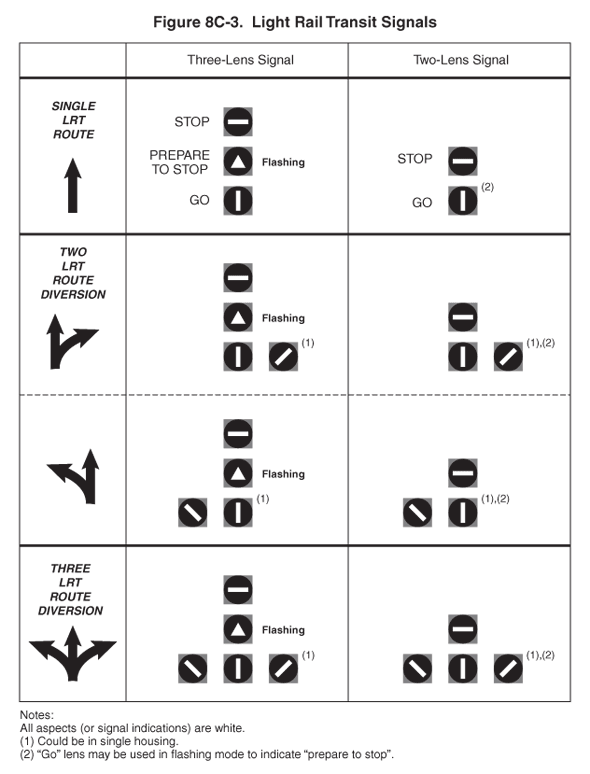2009 Edition Part 8 Figure 8C-3. Light Rail Transit Signals

Figure 8C-3. Light Rail Transit Signals
This figure illustrates 28 examples of light rail transit signals for four types of light rail transit routes.
The signals consist of horizontal, vertical, and diagonal white lines and an equilateral triangle on a circular black background. Signals for the following four types of light rail transit or LRT routes are shown: single LRT route, two LRT route diversion to the right, two LRT route diversion to the left, and three LRT route diversion. Both three-lens and two-lens signals for these routes are shown:
For the single LRT route, the three-lens signal shows a horizontal line for stop, a flashing triangle for prepare to stop, and a vertical line for go. The two-lens signal shows a horizontal line for stop and a vertical line for go. A note states that the "go" lens may be used in flashing mode to indicate "prepare to stop."
For the two LRT route diversion to the right, the three-lens signal shows a horizontal line for stop, a flashing triangle for prepare to stop, a vertical line for go straight, and a diagonal line pointing up and to the right for go to the right. A note states that the "go" lenses could be in a single housing. The two-lens signal shows a horizontal line for stop, a vertical line for go straight, and a diagonal line pointing up and to the right for go to the right. Notes state that the "go" lenses could be in a single housing and may be used in flashing mode to indicate "prepare to stop."
For the two LRT route diversion to the left, the three-lens signal shows a horizontal line for stop, a flashing triangle for prepare to stop, a vertical line for go straight, and a diagonal line pointing up and to the left for go to the left. A note states that the "go" lenses could be in a single housing. The two-lens signal shows a horizontal line for stop, a vertical line for go straight, and a diagonal line pointing up and to the left for go to the left. Notes state that the "go" lenses could be in a single housing and may be used in flashing mode to indicate "prepare to stop."
For the three LRT route diversion, the three-lens signal shows a horizontal line for stop, a flashing triangle for prepare to stop, a diagonal line pointing up and to the left for go to the left, a vertical line for go straight, and a diagonal line pointing up and to the right for go to the right. A note states that the "go" lenses could be in a single housing. The two-lens signal shows a horizontal line for stop, a diagonal line pointing up and to the left for go to the left, a vertical line for go straight, and a diagonal line pointing up and to the right for go to the right. Notes state that the "go" lenses could be in a single housing and may be used in flashing mode to indicate "prepare to stop."
The following notes are included:
All aspects (or signal indications) are white.
(1) Could be in single housing.
(2) "Go" lens may be used in flashing mode to indicate "prepare to stop."
